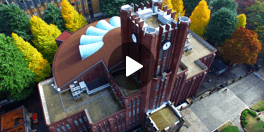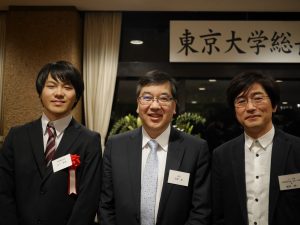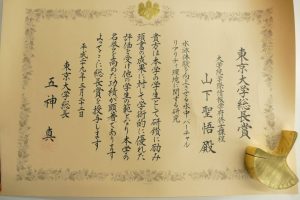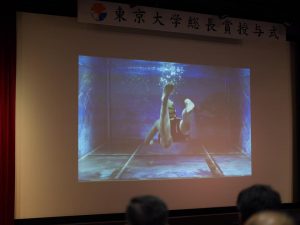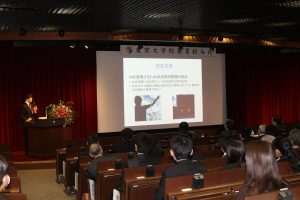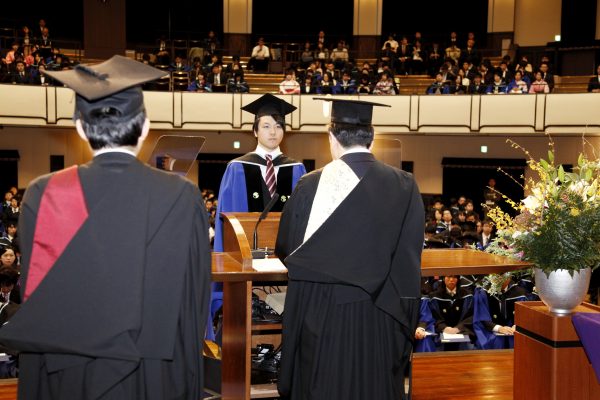
June 1, 2017
「総長賞」「学府長賞」受賞者 山下聖悟さんShogo Yamashita, a winner of the “University of Tokyo President’s Award” and “III/GSII Dean’s Award”
平成28年度に「総長賞」「学府長賞」をダブル受賞された山下聖悟さん(総合分析情報学コース 暦本研究室)に、研究のことや学際情報学府の受験生に向けて、留学先のシンガポールよりメッセージをいただきました。
——
研究について
修士課程では「水泳体験を向上させる水中バーチャルリアリティ環境に関する研究」というテーマで研究を行いました。
水泳は広く親しまれているスポーツであり、心身を健康に保つためのエクササイズとしても人気です。しかし、プール中での水泳は風景の変化を楽しむことができず、かつ単調な動作を繰り返す必要があるため、水泳を続けるモチベーションを保つことができない人が多いという問題がありました。
本研究では、バーチャルリアリティVRを用いて水泳のエンターテイメント性やトレーニング効率を向上させることを目指しました。VRとは、コンピュータグラフィックスで作られた仮想的な世界の中に、本当にユーザーが入り込んだような体験を提供することができる環境のことを言います。例えば、この研究が発展すると、プールの中にサンゴ礁に囲まれた海や、宇宙空間での水泳を仮想的に再現する事ができるようになります。
修士課程の間には、プール型VR 環境を実現するための技術的課題を明確化し解決しました。卒業時には、国際的で幅広い研究活動や成果を評価され東京大学 平成28年度学生表彰「東京大学総長賞」と「情報学環・学際情報学府長賞」を受賞しました。
国際的な研究活動について
私は修士2年と1年の間に1年間休学を行い、ベルギーの研究機関にて自動運転に関する研究開発に携わっていました。また、国内のIT企業の研究機関においても、海外から来たエンジニアとともにオンラインショッピングに関する研究開発を行いました。現在は、学際情報学専攻の博士課程への進学と同時にシンガポール国立大学の研究機関へ移動し、エンターテイメントから医療まで幅広く研究しています。私はこれらの経験から、いろいろな文化や技術的バックグランウンドを持つ人々が集まる学際的な環境が、視野を狭めずに研究活動するためのカギであると気がつきました。
学際情報学専攻について
学際情報学府にも文系理系を問わず様々な興味や知識を持った方々が集まっています。特に本専攻にはすべてのコースから学生が集まり共に課題を解決するような授業もあります。もし学際情報学府に入学されるのであれば、是非このような交流の機会を大切にしてください。私は今でも当時授業で同じグループだった方々とご飯に行ったり研究相談をしたりしています。その度に、彼ら彼女らからは新しい視点や知識、モチベーションを得られています。
記事:山下聖悟(博士課程)
This is a message from a PhD student, Shogo Yamashita in Singapore who received the “University of Tokyo President’s Award” and the “III/GSII Dean’s Award” in 2016.
——
About My Research
The topic of my master’s thesis was “AquaCAVE: Augmented Swimming Environment with Immersive Surround-Screen Virtual Reality”.
AquaCAVE is a system for enhancing the swimming experience. Swimming is considered to be one of the best exercises to maintain our health, but swimming in a pool is normally monotonous; thus, maintaining motivation is sometimes difficult. AquaCAVE is a computer-augmented swimming pool with rear-projection acrylic walls that surround a swimmer, providing an immersive stereoscopic projection environment. Swimmers can be immersed into synthetic scenes such as coral reefs, outer space, or any other computer generated environment.
During the two years of my master’s course, I clarified what technical problems needed to be resolved in order to realize an underwater virtual reality environment and provided solutions for them. I received the “University of Tokyo President’s Award for Students” and the “III/GSII Dean’s Award” because of the research results.
About International Research Activity
I took a gap year between the first and second years of my master’s course, and went to Europe to work on a project regarding driving automation at a company in Belgium. I have also worked at a Japanese IT company researching technologies related to online shopping with engineers from all over the world. I have since advanced to the PhD course in the Interfaculty Initiative in Information Studies while also moving to the National University of Singapore to work as a research engineer on a wide range of areas.
From these experiences, I realized that working in an interdisciplinary environment with people from diverse cultural and technical backgrounds is crucial if one is to maintain the breadth of one’s research perspective.
About GSII
The Graduate School of Interdisciplinary Information Studies (GSII) is the ideal environment since it brings students with different interests and knowledge together in the same department. For example, there is a special class where students from different courses in the department come together to consider solutions to real-world problems. This opportunity to communicate with other students will be of great benefit to you in the future. I still keep in touch with the students I met in that class. We sometimes meet to have discussions on our projects and eat together. I always learn something important and acquire motivation to work on my projects from them.
This article was written by Shogo Yamashita (PhD student)

